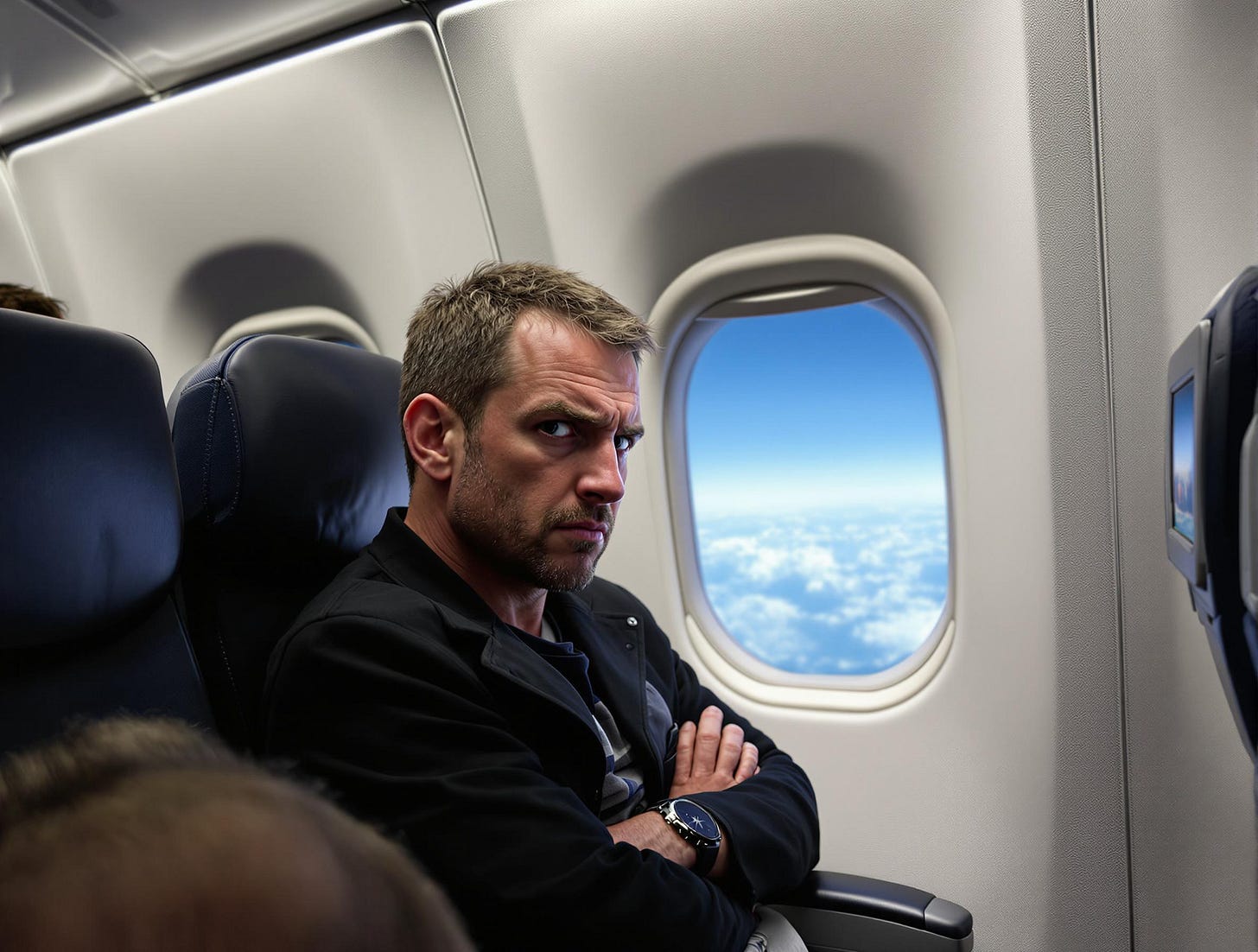Everyone Says Claustrophobia Means You Can't Fly. Here's Why They're Wrong (And What Actually Helps)
Claustrophobia isn't a no-fly zone. Here's how to stay calm at 35,000 feet.
Even seasoned travelers can feel trapped once that aircraft door closes with that distinctive thunk.
I've been flying for over two decades as a pilot and I've seen it happen hundreds of times. The confident business traveler who suddenly grips their armrest. The grandmother visiting family who starts breathing shallow and fast. Even fellow pilots, believe it or not, who've quietly admitted their struggle with cabin confinement.
The conventional wisdom? "People with claustrophobia just can't fly." Friends suggest driving cross-country. Family members offer to cancel trips. The internet is full of horror stories that make flying seem impossible for anyone who struggles with tight spaces.
But here's what I've learned from thousands of flights and countless conversations with passengers: claustrophobia doesn't have to stop you from flying.
The strategies that actually work aren't what most people expect. And once you understand them, that cramped cabin transforms from a prison into just another space you can handle maybe even master.
Here's what I've seen help thousands of passengers, and what might help you.
What Most People Try (And Why It Backfires)
Walk through any airport bookstore and you'll find the same advice repeated endlessly: distract yourself. Load up your phone with movies. Bring puzzles. Take medication. White-knuckle through it.
I've watched passengers try all of these approaches. Some work temporarily, but most create new problems.
The distraction trap: When you're desperately trying not to think about the cabin, you're actually thinking about it constantly. Your brain keeps checking: "Am I distracted enough? Is this working? Oh no, I'm thinking about the space again."
The medication mistake: Anti-anxiety medication can help, but it often leaves people feeling foggy and disconnected—which can actually increase that "trapped" feeling. You're chemically calm but mentally alert enough to notice you can't think clearly.
The endurance myth: Trying to simply "tough it out" turns every flight into a battle. You spend hours in fight-or-flight mode, which exhausts you and makes future flights seem even more daunting.
I've seen passengers try these approaches flight after flight, getting more frustrated each time. The problem isn't that they lack willpower. The problem is they're fighting the wrong battle.
The Discovery That Changes Everything
The breakthrough came when I started noticing which passengers naturally stayed calm, even in tight quarters.
It wasn't the ones with the most distractions or the strongest medication. It was the passengers who were engaged with their environment rather than fighting it.
The calm flyers were doing something counterintuitive: instead of trying to mentally escape the cabin, they were connecting with it. They'd feel the air circulation system working. They'd watch the wing flex slightly in turbulence (which is perfectly normal and safe). They'd notice the flight attendants moving efficiently through their routines.
This led to a revelation: the problem isn't the space itself, it's feeling disconnected from control and understanding.
From the cockpit, I see something passengers don't: the cabin isn't actually small. It's a carefully engineered environment with multiple air exchanges per minute, emergency exits strategically placed, and systems designed for your safety and comfort. When you understand this and connect with it, everything changes.
The most effective techniques work because they shift your focus outward and ground you in reality:
Breathing with the aircraft: Instead of fighting your breathing, sync it with the plane's rhythm. Feel the slight pressurization changes during climb and descent. This isn't just distraction, it's connection.
Visual anchoring: Find something in your sight line that represents space and freedom. The window view works, but so does watching the aisle, noticing the ceiling height, or observing how easily people move around.
Posture positioning: Small adjustments make a huge difference. Feet flat on the floor, shoulders back, claiming your space confidently. Your body language tells your brain whether you're trapped or in control.
The Results Speak for Themselves
Sarah almost didn't board her flight to her daughter's wedding. She'd driven everywhere for fifteen years to avoid flying. Sitting in the airport, she was minutes from buying a bus ticket home.
Instead, she tried one simple technique: for the first ten minutes after boarding, she focused entirely on the air conditioning vents above her seat. Not as distraction, but as connection. She felt the steady airflow, noticed how it created circulation throughout the cabin, realized she could adjust it for comfort.
"I stopped feeling trapped," she told me later, "because I realized I wasn't trapped. I was in a space designed to take care of me."
Marcus, a software engineer, had panic attacks on three consecutive flights. He was ready to quit his job rather than travel for work. The game-changer for him was understanding the pilot's perspective: "You helped me see that from the cockpit, we're not managing a cramped tube, we're operating a sophisticated system designed for comfort and safety. Once I understood that, I could trust it."
From my perspective in the cockpit, I see the cabin differently than passengers do. It's not a confined space, it's a controlled environment. Every system has backups. Every measurement is monitored. The aircraft is constantly "talking" to us about pressure, temperature, air quality, and structural integrity.
When passengers understand this, when they connect with the aircraft as a functioning system rather than fighting it as a prison, the anxiety often dissolves.
Your Flight Toolkit 🛠️: What Actually Works
Here are the techniques that consistently help, based on what I've seen work for real passengers on real flights:
Before boarding: Arrive early and watch planes taxi, take off, and land. This reminds your brain that flying is routine and controlled, not chaotic and dangerous.
During boarding: Choose an aisle seat if possible, but don't rely on it. Practice claiming your space confidently, regardless of where you sit.
First ten minutes: Focus on one aircraft system. The air vents, the lighting, the way the flight attendants move efficiently through their safety checks. Connect with the aircraft as a functioning environment.
During flight: When anxiety builds, ground yourself in specifics. What do you hear? (The consistent hum of engines working perfectly.) What do you feel? (Steady air circulation, the solid structure around you.) What do you see? (Professional crew, other calm passengers, the view outside.)
The altitude advantage: Remember that at cruising altitude, you're in the safest part of the flight. The aircraft is in its element, systems are operating optimally, and you're surrounded by hundreds of miles of open sky.
Common trap to avoid: Don't fixate on the door or emergency exits. This reinforces the "trapped" feeling. Instead, focus on systems that demonstrate the aircraft's active care for your comfort.
The Truth About Flying with Claustrophobia
Here's what I want you to understand: it's not about learning to love small spaces. You don't have to become someone who enjoys feeling confined.
It's about trusting that you can handle temporary confinement when it serves a purpose like getting you safely to people and places that matter to you.
The aircraft cabin isn't trying to trap you. It's trying to protect you while carrying you efficiently through an environment humans weren't designed to survive in. When you understand this and work with it rather than against it, everything changes.
Your claustrophobia doesn't disqualify you from flying. It just means you need better tools and a clearer understanding of what you're actually dealing with.
Try one of these techniques on your next flight even if it's just focusing on the air circulation for the first few minutes after boarding. Notice what changes. Pay attention to how your body responds when you connect with the aircraft instead of fighting it.
And tell me how it goes. I'm here to help, whether you're planning your first flight in years or looking to make your regular travel more comfortable.
The sky is bigger than any cabin, and it's waiting for you.
Have you tried flying with claustrophobia? What worked (or didn't work) for you? Reply and let me know—I read every message and often feature reader stories in future posts.
Pilot Nick









My problem is slightly different. Flying has never bothered me, even in turbulence. What I do struggle with is airports! I’m on the autistic spectrum and find them an absolute sensory nightmare. And security checks leave me feeling like a criminal - irrational, I know, but true. If my daughter didn’t live abroad, in a country it’s not really practical to reach by train, I’d probably stop flying altogether. Is this a common problem, I wonder?
This is very helpful.
I'll share via email to a friend who has this fear😩
Thanks for sharing.